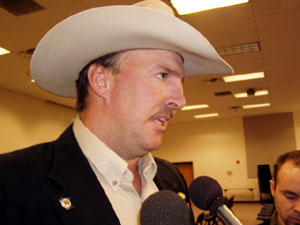|
Audio
Photos
More from MPR
Resources
Your Voice
|
State health, agriculture leaders work to ease mad cow fears
December 31, 2003
 |
| Minnesota cattleman Steve Brake says he's lost about $300 lost for every animal he brings to market. (MPR Photo/Tom Scheck) |
St. Paul, Minn. — Steve Brake is seeing the effects of mad cow disease firsthand. The president of the Minnesota State Cattleman's Association, who owns a cattle farm in southwest Minnesota, says before mad cow was detected in the United States, he was getting 93 cents for every pound of beef he'd sell to the slaughterhouse. He says the price has dropped to 73 cents a pound.
Brake says that equates to about $300 lost for every animal he brings to market. He says he's confident that the new safeguards will ensure that no sick animals get into the food supply. But he's worried that consumers might buy something other than beef at a restaurant or supermarket.
"The economics of this are going to be very staggering for producers and that's just the first of many loads of cattle that we have ready to go. And so those are things that I, as president of this organization, are going to have to figure out how to deal with. How we're going to keep our family farmers going," he said.
Brake says the USDA's decision to ban distribution of meat from cattle that can't walk or stand on their own is a good step to bring back consumer confidence. He also says American cattle farmers have not recycled cattle remains into feed for other cattle since 1997. Researchers say mad cow disease is likely spread through that process.
The reason for concern is that mad cow can also be transmitted to humans. The Centers for Disease Control and Prevention in Atlanta say 153 people are believed to have died as a result of an outbreak in the United Kingdom in the 1990s.
Many health experts, however, believe that the steps taken after the UK outbreak and the discovery in Washington last week are adequate. The Minnesota Health Department's Richard Danila says the protein suspected of causing mad cow has not shown up in the muscle that makes up most cuts of meat. He says people will be fine as long as they avoid eating the brains, spinal cord and small intestine of a cow.
"It's a very low risk. You can't say it's zero, but it's very, very low and you need to put that risk into perspective with the risks that you take everyday in what you choose to eat and the illness it might cause," according to Danila.
Danila and other experts took part in a video conference that was streamed to 10 sites throughout the state.
Some participants wondered if they can take their own downed cattle to a slaughterhouse if they intend to use the beef for family consumption. Officials say that's OK, but it cannot be sold. Others wanted to know if the cattle remains were used in other types of feed. Agriculture officials say cattle remains are recycled and used in feed for pigs, poultry, dogs and cats. Scientists say mad cow hasn't shown up in pigs, poultry, or dogs. They say some cats have contracted the illness, but it's because their cat food came directly from a butcher
Mike Coyle, who took part in the video conference in St. Paul, says he believes that any animal five years old or older should be tested for mad cow before its parts go to market. He says those animals may have eateN feed that was contaminated with mad cow. Coyle says the USDA decision to prevent any downer cattle to enter the food supply does not go far enough.
"In my mind that does very little in protecting the food supply because it's been presented here today that a lot of the downer animals have broken legs or had birthing problems, etc. Animals that are not in a risk population, but we seem to purposely avoiding animals that are in a risk population," acccording to Coyle.
The University of Minnesota's Will Hueston says he's confident that the USDA's announcement to double its testing for mad cow will ensure that mad cow won't end up on the dinner table. Hueston says the federal government tested 20,000 cattle last year for mad cow and expects that number to at least double next year Hueston says USDA will target its testing on old, sick or downer cattle.
"The strategy that is being implemented at the moment is to increase the level of surveillance and then target that surveillance specifically at those high risk categories of older animals," Hueston said.
Hueston says one area of concern may come from t-bone steaks. He says that part comes from the area where the backbone meets the rib. He says sometimes the meeting point still contains a piece of the spinal cord, which should not be eaten.
|
News Headlines
|
Related Subjects
|
